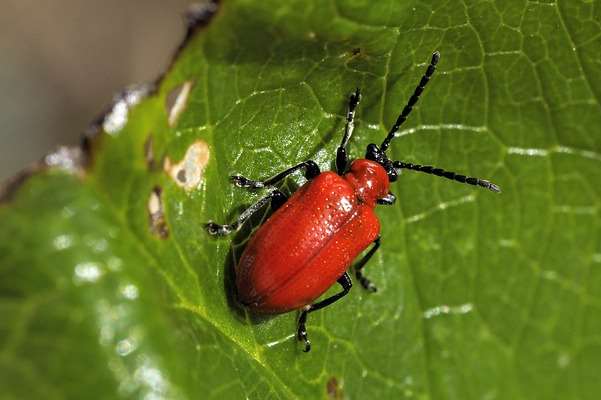Tiny red bugs in the house can be quite bothersome as some of them bite and others leave behind a red stain if you squash them. Among these crimson-colored creatures, chiggers and red clover mites are the most common. These minuscule reddish-brown insects can be difficult to spot. Additionally, red spider mites, red scarlet beetles, and black and red boxelder bugs are some other red bugs that might find their way into your home.
If you notice red bite marks or welts on your skin, it could be a sign that these red bugs have invaded your home. During autumn, a significant number of these small red insects and mites may seek shelter indoors. Initially, red stains on your mattress might be mistaken for bed bug or other blood-sucking insect markings, indicating the presence of these pests. Have you ever come across little red creatures hiding in the shadows? In such cases, it’s crucial to know how to eliminate these pests and whether they pose any harm or transmit infections.
This article aims to help you identify the red bugs that may be present in your house. In certain situations, close-up images are necessary to properly observe the distinctive features of these bugs. Additionally, you will learn useful tips on how to effectively get rid of these red bugs.
What Are Red Bugs?
Red bugs encompass a range of species, including beetles, mites, arachnids, and insects. Some red bugs are so tiny that you’ll need a magnifying glass to see them. Others, like the scarlet lily beetle, have vibrant red bodies that make them easily recognizable. Red bugs come in various sizes, ranging from 0.01 to 0.35 inches (0.4 to 9 mm) in length.
Many red bugs found in houses are microscopic and cannot be seen with the naked eye. Chiggers, for instance, are tiny red mites that cause significant discomfort to people. These tick-like pests measure just 0.01 inch (0.4 mm) in length. Similarly, red clover mites are approximately 0.03 inches (0.75 mm) long.
Most red bugs and mites have oval or tear-shaped bodies with six or eight legs, depending on whether they’re insects or arachnids. However, due to their minuscule size, it can be challenging to identify these tiny insects at home without a strong magnifying lens. While many people refer to small red pests as red bugs, not all of them are true bugs in the scientific sense. The boxelder bug, belonging to the Hemiptera insect order, is the only authentic red bug in this list. Its adults are black and red beetles, while the nymphs are bright red.
Red bugs are classified as creatures within the phylum Arthropoda, which includes red clover mites, chiggers (berry bugs), scarlet lily beetles, and spider mites. However, they are often referred to as red bugs mainly due to their nuisance factor.
Types of Tiny Red Bugs (Overview)
When it comes to red bugs, some common species you may encounter indoors and outdoors include red clover mites, red berry bugs, red spider mites, scarlet lily beetles, and boxelder bugs. Out of these, the scarlet lily beetles and boxelder bugs are the only ones that can be easily recognized without any magnifying tools – you can simply spot them with your naked eye.
Types of Red Bugs (with Pictures) — Identification Guide
Now, let’s delve into the diverse array of red insects, mites, and arthropods that you might come across in and around your home or yard.
Red Clover Mites (Bryobia praetiosa)
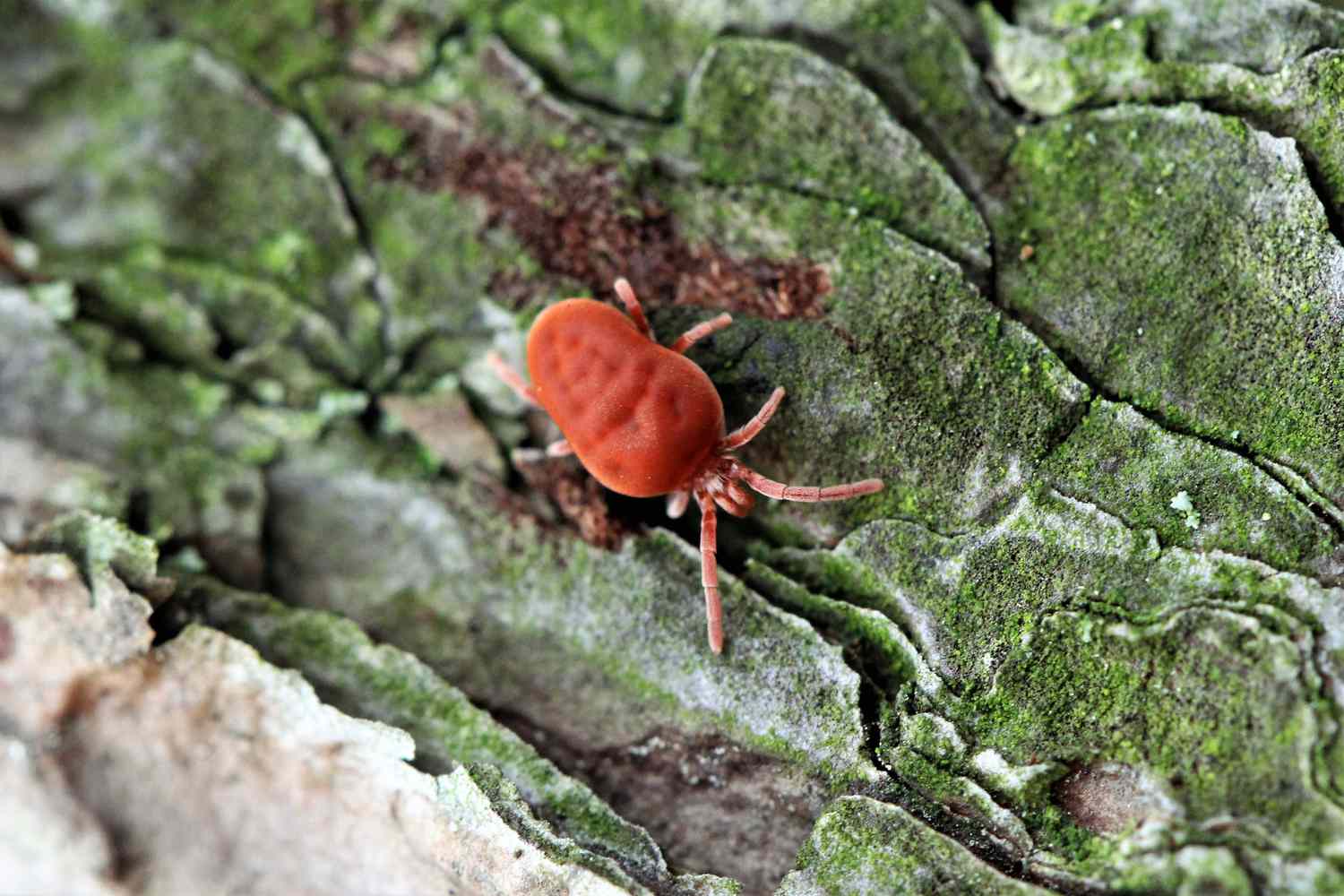
Red clover mites, small plant-feeding mites, can become troublesome if they start multiplying indoors. These tiny red bugs have an oval-shaped body with eight legs and a reddish-brown color. One identifying feature of the clover mite is its extended front legs that resemble antennae. They measure around 0.75 mm in length, which is roughly 0.03 to 0.033 inches (0.75 to 0.85 mm).
Clover mites, almost invisible due to their size, primarily feed on plants in gardens. However, after heavy rain or during hot summers, they can become a nuisance indoors. They also tend to enter houses in the spring and when the weather cools down.
You may spot red clover mites crawling on doors, windows, and walls. Although they have an eight-legged body and are characterized by tiny red or brown dots or pinpricks, red clover mites simply appear as moving specks. When squished, they can leave behind reddish stains.
These stains are caused by the red pigment emitted from the mites’ bodies. In the garden, red clover mites can be found on decorative flowers, dandelions, daffodils, primroses, and other grassy areas. Evidence of red clover mite damage includes small silvery streaks on leaves, and their large numbers can lead to brown patches in lawns.
Red clover mites are often brought indoors when there are changes in the weather or excessive rain. Moisture tends to attract various bugs, including red clover mites. If you have vegetation near your foundations, it increases the risk of attracting a wide range of pests into your home.
The most significant issue with red clover mites indoors is the distinctive red stains they leave behind. Many people mistake these red stains on carpets, mattresses, or sofas for bed bug or tick markings due to their similar appearance. However, it’s important to note that red clover mites do not bite humans or feed on blood.
Identification of Tiny Red Bugs
If you notice small, dark red or brown marks moving along walls, doors, and windows, chances are you have red clover mites. Under a microscope, these reddish-brown mites display an oval body, feather-like plates on the abdomen, and eight legs, with two extending forward at the front.
Getting Rid of Tiny Red Clover Mites
The best approach to eliminate tiny red clover mites is to prevent them from entering your home. Create a clearance of at least 2 feet (60 centimeters) between your house and any mulch, grass, or plants. This helps deter a red bug invasion.
Utilize a vacuum cleaner to suck up red clover mites indoors. This prevents squashing them and staining your curtains, carpets, or upholstery. After vacuuming the bothersome red bugs, either destroy the dust bag or dispose of it far away from your home. Additionally, sealing tiny cracks in the foundation, especially around windows, doors, and where pipes enter the building, is crucial.
Berry Bugs / Chiggers (Trombicula)
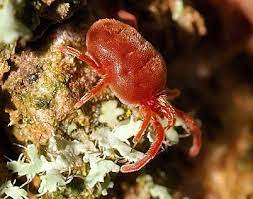
Chiggers are minuscule red bugs that bite and can cause itchy skin swellings. A close-up photograph depicts these red, oval-shaped creatures with six legs. Typically, the itchy, pimple-like bumps they leave on the skin are the primary way to identify these tiny red arachnids.
Chiggers are also known by various names such as berry bugs, scrub-itch mites, harvest lice, harvest mites, or simply red bugs. Contrary to popular belief, they are more closely related to ticks and spiders than insects. Chiggers are extremely small, measuring no more than 0.01 inches (0.4 mm) in size.
Similar to other arachnids, chiggers possess eight legs. They are nearly invisible to the naked eye. Under a microscope, one can observe their oval-shaped, bulbous body and tiny head. The red color of chiggers is not due to a blood meal but rather their natural physiology.
The life cycle of a chigger begins when a female lays eggs in leaf litter on the ground. Once hatched, the larvae have a bright red body with six legs. After seeking a host for a blood meal, they start feeding. Following a full meal, the microscopic red insects molt into eight-legged adults. Chiggers are commonly found in grassy and bushy areas during the afternoon. Walking through such environments in late spring to early autumn increases the risk of chigger bites.
Do chiggers have teeth? While the larvae of adult chiggers do not technically bite, they attach themselves to a host and use their pointed jaws to inject saliva, causing a bite. This is typically followed by an itchy, swollen irritation that can last for several days. In some cases, the rash may persist for a few weeks and continue to itch.
After being outdoors, it is advisable to check yourself for chiggers. You may spot small red dots scurrying across your skin. If signs of chiggers are present, thoroughly wash yourself with soap and water. Additionally, launder your clothes in hot water to eliminate any red bugs that may be hiding there.
Identification of Tiny Red Bugs
Bite marks on the skin in the form of red, itchy welts are a common indication of chigger presence. Adult chiggers have a red body and eight legs. These tiny insects measure a mere 0.01 inch (0.4 mm), while the larvae are even smaller at only 0.0066 inch (0.17 mm).
Getting Rid of Tiny Red Bugs
Upon returning indoors from outdoor areas where chiggers are known to reside, it is crucial to thoroughly wash yourself. This includes washing any clothing worn outdoors. This practice helps eliminate any unwelcome bugs that may have been inadvertently brought home. Since chiggers do not survive long indoors, they rarely pose a threat within the home. However, if you suspect red bugs to be the source of an issue, use a vacuum cleaner to remove them and wipe down surfaces with a natural disinfectant solution.
Tiny Red Spider Mites (Tetranychus urticae)

Red spider mites, also known as little red bugs, are tiny arachnids that can be found crawling on plants or creating webbing beneath plant leaves. These red mites measure a mere 0.016 inch (0.4 mm) in length and have a distinctive red color. Close-up images showcase their oval-shaped bodies and the presence of eight spiky legs, characteristic of these red insects.
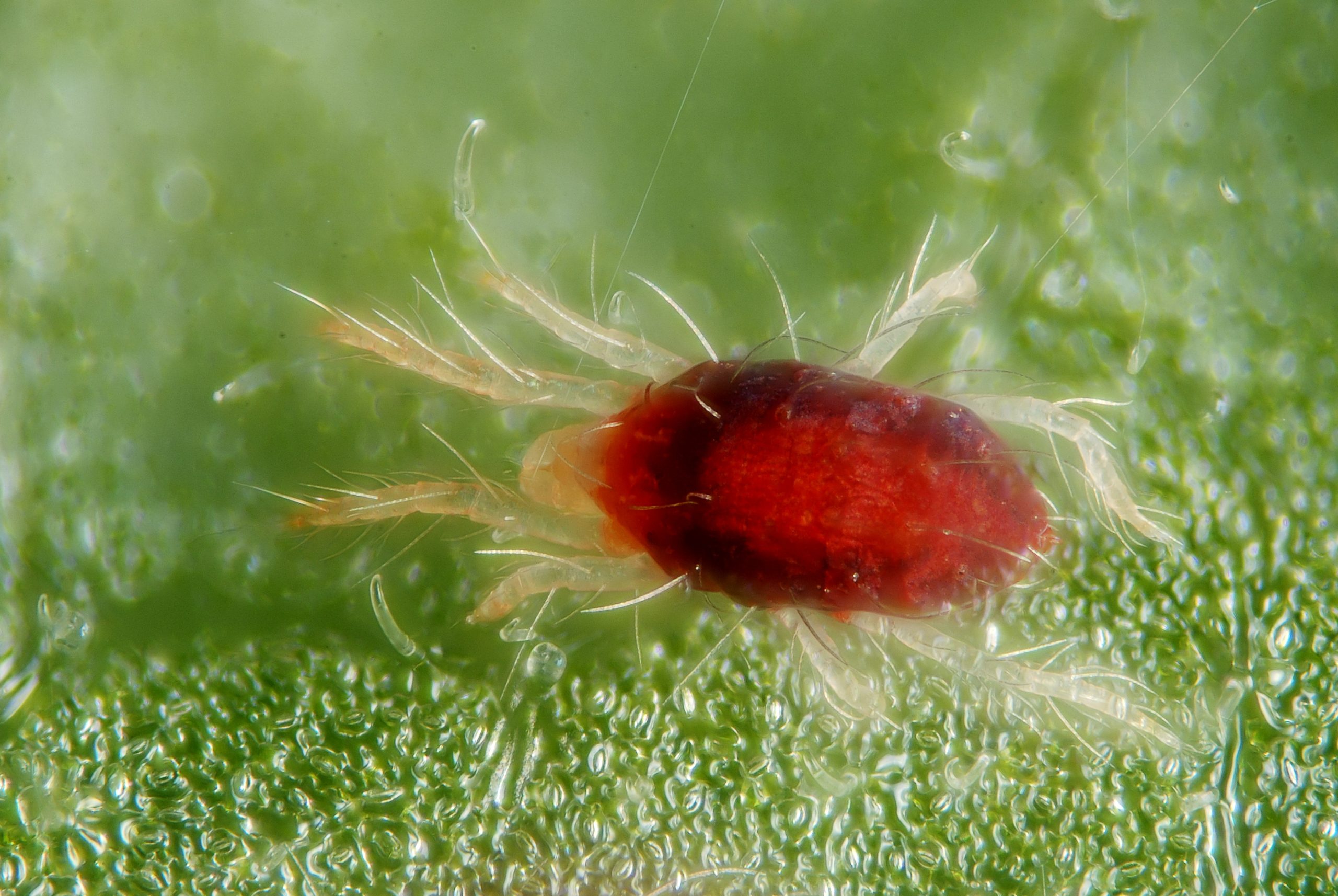
Spider mites are a common menace to house plants. The image provided offers a close-up view of one of these tiny red mites. These pesky creatures have sharp teeth and bite into plant tissues, subsequently sucking out the fluids from leaves and stems. Their destructive feeding habits can lead to yellowing leaves, the formation of spots, withering, and even the death of plants.
Identifying red spider mites on plants can be quite challenging. Without the aid of a magnifying glass, they are hardly noticeable to the naked eye. However, the presence of webbing or delicate strands of silk beneath the leaves serves as an initial indicator of a spider mite infestation. Red spider mites can infest a variety of plants, including houseplants, vegetable crops, fruit bushes, fruit trees, and citrus trees.
In greenhouses, they pose a threat to plants such as tomatoes, eggplants, and cucumbers. Within this controlled environment, they can wreak havoc and cause significant damage to these valuable crops.
Tiny red bug identification

To identify red spider mites, pay attention to the presence of webbing between leaves and stems as well as beneath the leaves of plants. Even a few delicate strands of silky webbing can confirm the presence of these pests. Another method is to tap the leaves and check if any red mites fall onto a piece of white paper placed beneath. If you observe these signs, it is safe to assume that there is a severe infestation of red spider mites.
In such cases, you may notice various symptoms indicating the impact of the infestation. Look out for yellowing leaves, the formation of leaf spots, brown patches on blooms, and premature leaf drop. These are common indicators of the damage caused by red spider mites.
To confirm the presence of spider mites when in doubt, utilize a 10x or 15x hand lens. With the aid of this magnifying tool, observe beneath the leaves and within the webbing for small red dots that appear like pinpricks. These moving red dots are indicative of spider mites. Additionally, you may also come across tiny white or greenish dots, which could represent different varieties of spider mites.
How to get rid of tiny red spider mites
For effective eradication of red spider mites from houseplants or decorative garden bushes, utilizing neem oil is highly recommended. You can create a DIY neem oil solution by mixing 2 teaspoons of organic neem oil with 1 quart of warm water and a small amount of Castile soap. Once the solution is ready, pour it into a spray bottle and thoroughly spray both sides of the leaves to target the spider mites. To achieve optimal results, reapply the neem oil solution every seven days and allow it to dry on the leaves.
Another natural spray that can be used for controlling red spider mites is a mixture of rubbing alcohol and water in a 1:1 ratio. This spray can be applied to the leaves of plants infested with spider mites, followed by wiping the leaves clean. In the case of vegetable plants affected by red spider mites, spraying the leaves with a garden hose can also be effective. The forceful sprays of water help dislodge the spider mites and other pests from the plant leaves.
Red Lily Beetle / Red Scarlet Beetle (Lilioceris lilii)

The scarlet lily beetle is a vivid crimson insect with black legs and antennae that feeds on various parts of lily plants, including leaves, stems, buds, and flowers. These beetles measure around 0.25 to 0.35 inches (6 to 9 mm) in length and exhibit a striking bright red coloration. They possess a scarlet red body with a crimson thorax, while their heads are black and feature two antennae. Notably, their long legs are quite distinct.
Species of plants such as Lilium and Fritillaria are particularly susceptible to significant damage caused by these red and black beetles. Holes in lily leaves are the initial signs of beetle damage, while sticky brown frass (excrement) deposits can also be observed on the leaves.
Over time, beetles that target plants can defoliate the entire plant if left unchecked. A practical method to control them is to manually remove the red lily beetles from the plants. It is advisable to first clean off frass mounds, where larvae might be present, using a rubbing alcohol solution. Subsequently, pick off the beetles and drop them into a bucket of soapy water.
Neem oil can also be an effective solution for eliminating both red scarlet beetle larvae and adults from lily plants. Apply a neem oil solution to all the plant’s leaves every five to seven days, particularly after the larvae have emerged, to effectively combat the infestation.
Red bug identification
The red lily scarlet beetle stands out with its vibrant scarlet-red oval body and thorax. It is characterized by six black legs, two black antennae with eleven segments each, and a small black head. These distinctive features make it easily recognizable. The red and black beetles are commonly observed on lily plants.
Boxelder Bug (Boisea trivittata)
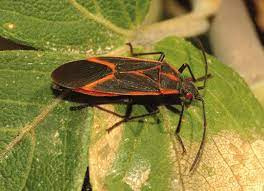
Boxelder bugs possess six black legs and two long, arching antennae. These winged bugs showcase a combination of red and black colors in their adult form. However, their nymphs appear vividly red, despite their overall appearance being more black or brown than red. The immature red bugs have an elongated oval shape and take approximately 50 to 78 days to reach maturity. Interestingly, during their nymphal phase, the vibrant red color fades, transitioning into a darker brownish to black hue.
Adult boxelder bugs can often be found flying between boxelder trees, ash trees, and maple trees. During the summer, these small red insects can make their way into homes through open windows, doors, or gaps in the building structure. If they find cracks or openings, you may notice groups of them climbing up the exterior of your home.
The most effective method of dealing with boxelder bugs is to prevent their entry into your home. Installing window or door screens can help keep these red and black insects out. Additionally, caulking around windows and walls can further deter them from finding their way inside.
If you come across groups of boxelder bugs around your home, you can use insecticidal soap or hot soapy water to spray and dislodge them. This can help in both removing them from your immediate vicinity and killing them.
